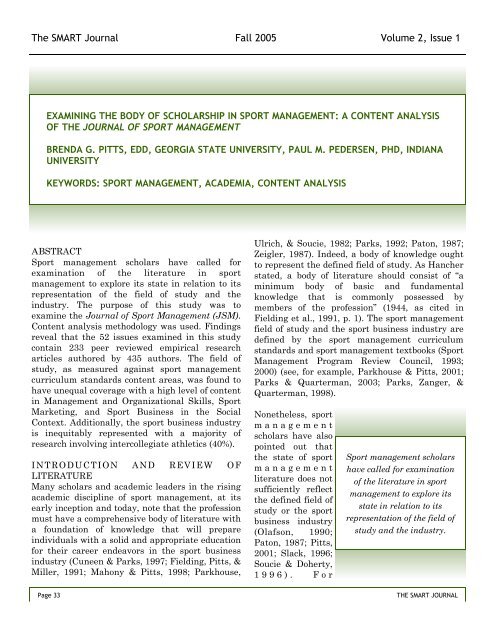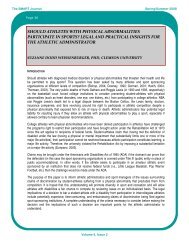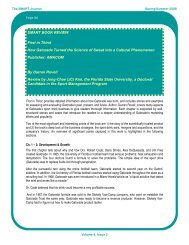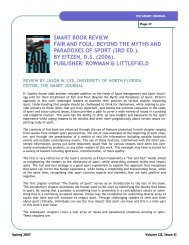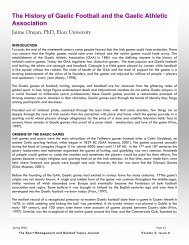examining the body of scholarship in sport management
examining the body of scholarship in sport management
examining the body of scholarship in sport management
You also want an ePaper? Increase the reach of your titles
YUMPU automatically turns print PDFs into web optimized ePapers that Google loves.
SMART Onl<strong>in</strong>e Journal Volume 2, Issu e 1The SMART Journal Fall 2005 Volume 2, Issue 1EXAMINING THE BODY OF SCHOLARSHIP IN SPORT MANAGEMENT: A CONTENT ANALYSISOF THE JOURNAL OF SPORT MANAGEMENTBRENDA G. PITTS, EDD, GEORGIA STATE UNIVERSITY, PAUL M. PEDERSEN, PHD, INDIANAUNIVERSITYKEYWORDS: SPORT MANAGEMENT, ACADEMIA, CONTENT ANALYSISABSTRACTSport <strong>management</strong> scholars have called forexam<strong>in</strong>ation <strong>of</strong> <strong>the</strong> literature <strong>in</strong> <strong>sport</strong><strong>management</strong> to explore its state <strong>in</strong> relation to itsrepresentation <strong>of</strong> <strong>the</strong> field <strong>of</strong> study and <strong>the</strong><strong>in</strong>dustry. The purpose <strong>of</strong> this study was toexam<strong>in</strong>e <strong>the</strong> Journal <strong>of</strong> Sport Management (JSM).Content analysis methodology was used. F<strong>in</strong>d<strong>in</strong>gsreveal that <strong>the</strong> 52 issues exam<strong>in</strong>ed <strong>in</strong> this studyconta<strong>in</strong> 233 peer reviewed empirical researcharticles authored by 435 authors. The field <strong>of</strong>study, as measured aga<strong>in</strong>st <strong>sport</strong> <strong>management</strong>curriculum standards content areas, was found tohave unequal coverage with a high level <strong>of</strong> content<strong>in</strong> Management and Organizational Skills, SportMarket<strong>in</strong>g, and Sport Bus<strong>in</strong>ess <strong>in</strong> <strong>the</strong> SocialContext. Additionally, <strong>the</strong> <strong>sport</strong> bus<strong>in</strong>ess <strong>in</strong>dustryis <strong>in</strong>equitably represented with a majority <strong>of</strong>research <strong>in</strong>volv<strong>in</strong>g <strong>in</strong>tercollegiate athletics (40%).INTRODUCTION AND REVIEW OFLITERATUREMany scholars and academic leaders <strong>in</strong> <strong>the</strong> ris<strong>in</strong>gacademic discipl<strong>in</strong>e <strong>of</strong> <strong>sport</strong> <strong>management</strong>, at itsearly <strong>in</strong>ception and today, note that <strong>the</strong> pr<strong>of</strong>essionmust have a comprehensive <strong>body</strong> <strong>of</strong> literature witha foundation <strong>of</strong> knowledge that will prepare<strong>in</strong>dividuals with a solid and appropriate educationfor <strong>the</strong>ir career endeavors <strong>in</strong> <strong>the</strong> <strong>sport</strong> bus<strong>in</strong>ess<strong>in</strong>dustry (Cuneen & Parks, 1997; Field<strong>in</strong>g, Pitts, &Miller, 1991; Mahony & Pitts, 1998; Parkhouse,Page 33Ulrich, & Soucie, 1982; Parks, 1992; Paton, 1987;Zeigler, 1987). Indeed, a <strong>body</strong> <strong>of</strong> knowledge oughtto represent <strong>the</strong> def<strong>in</strong>ed field <strong>of</strong> study. As Hancherstated, a <strong>body</strong> <strong>of</strong> literature should consist <strong>of</strong> “am<strong>in</strong>imum <strong>body</strong> <strong>of</strong> basic and fundamentalknowledge that is commonly possessed bymembers <strong>of</strong> <strong>the</strong> pr<strong>of</strong>ession” (1944, as cited <strong>in</strong>Field<strong>in</strong>g et al., 1991, p. 1). The <strong>sport</strong> <strong>management</strong>field <strong>of</strong> study and <strong>the</strong> <strong>sport</strong> bus<strong>in</strong>ess <strong>in</strong>dustry aredef<strong>in</strong>ed by <strong>the</strong> <strong>sport</strong> <strong>management</strong> curriculumstandards and <strong>sport</strong> <strong>management</strong> textbooks (SportManagement Program Review Council, 1993;2000) (see, for example, Parkhouse & Pitts, 2001;Parks & Quarterman, 2003; Parks, Zanger, &Quarterman, 1998).None<strong>the</strong>less, <strong>sport</strong><strong>management</strong>scholars have alsopo<strong>in</strong>ted out that<strong>the</strong> state <strong>of</strong> <strong>sport</strong><strong>management</strong>literature does notsufficiently reflect<strong>the</strong> def<strong>in</strong>ed field <strong>of</strong>study or <strong>the</strong> <strong>sport</strong>bus<strong>in</strong>ess <strong>in</strong>dustry(Olafson, 1990;Paton, 1987; Pitts,2001; Slack, 1996;Soucie & Doherty,1996). ForSport <strong>management</strong> scholarshave called for exam<strong>in</strong>ation<strong>of</strong> <strong>the</strong> literature <strong>in</strong> <strong>sport</strong><strong>management</strong> to explore itsstate <strong>in</strong> relation to itsrepresentation <strong>of</strong> <strong>the</strong> field <strong>of</strong>study and <strong>the</strong> <strong>in</strong>dustry.THE SMART JOURNAL
SMART Onl<strong>in</strong>e Journal Volume 2, Issu e 1The SMART Journal Volume 2, Issue 1<strong>in</strong>stance, Slack stated that “<strong>sport</strong> <strong>management</strong>has not kept pace with <strong>the</strong> type <strong>of</strong> changes thathave occurred <strong>in</strong> <strong>the</strong> world <strong>of</strong> <strong>sport</strong>” and that “ourresearch is still very much dom<strong>in</strong>ated by studies <strong>of</strong>physical education and athletic programs” (p. 97).Pitts (2001) stated that “when one reads <strong>the</strong>totality <strong>of</strong> our literature, one gets <strong>the</strong> dist<strong>in</strong>ctimpression that <strong>sport</strong> <strong>management</strong> is noth<strong>in</strong>gmore than <strong>the</strong> study <strong>of</strong> manag<strong>in</strong>g college athleticsand some pr<strong>of</strong>essional <strong>sport</strong>s” (p. 3). In a study onone journal, <strong>the</strong> Sport Market<strong>in</strong>g Quarterly (SMQ),Pedersen and Pitts (2001) stated that <strong>the</strong> journalshould make changes <strong>in</strong> order to ensure itsrelevance to <strong>the</strong> field <strong>of</strong> <strong>sport</strong> <strong>management</strong>because <strong>the</strong>y found that <strong>the</strong>re are “unevenamounts <strong>of</strong> coverage <strong>of</strong> <strong>the</strong> basic <strong>sport</strong> market<strong>in</strong>gcomponents, <strong>sport</strong> <strong>in</strong>dustry segments, anddifferent <strong>sport</strong>s” (p. 23).These statements are supported by f<strong>in</strong>d<strong>in</strong>gs <strong>of</strong>o<strong>the</strong>r studies and reviews <strong>of</strong> <strong>the</strong> <strong>body</strong> <strong>of</strong> literature<strong>in</strong> <strong>sport</strong> <strong>management</strong>. In <strong>the</strong> earliest known study,Parkhouse et al. (1982) exam<strong>in</strong>ed 336 <strong>sport</strong><strong>management</strong> doctoral studies reported <strong>in</strong>Dissertation Abstracts International between 1950and 1980. It was concluded that <strong>the</strong> studies thatwere conducted dealt almost exclusively withphysical education and athletics at <strong>the</strong> collegiatelevel. Lambrecht (1991) conducted an exam<strong>in</strong>ation<strong>of</strong> 45 articles published <strong>in</strong> <strong>the</strong> Journal <strong>of</strong> SportManagement (JSM) from 1987-1990. Lambrechtnoted that 35% <strong>of</strong> <strong>the</strong> articles focused on college,university, and school issues while <strong>the</strong> rema<strong>in</strong><strong>in</strong>g65% covered numerous o<strong>the</strong>r topics. However, nos<strong>in</strong>gle topic was represented more <strong>of</strong>ten than <strong>the</strong>college, university, and school sett<strong>in</strong>g. Paton(1987) conducted an exam<strong>in</strong>ation <strong>of</strong> 122 <strong>sport</strong><strong>management</strong> studies reported <strong>in</strong> CompletedResearch <strong>in</strong> Health, Physical Education, andRecreation and found that 60% focused on <strong>the</strong>college and university sett<strong>in</strong>g. Soucie and Doherty(1996) conducted a study whose stated purposewas “to identify past research endeavors <strong>in</strong> <strong>sport</strong><strong>management</strong> and exam<strong>in</strong>e…<strong>the</strong> topics and areas<strong>of</strong> concern that have preoccupied research <strong>in</strong> thisfield (p. 142).” They exam<strong>in</strong>ed 288 NorthAmerican Society for Sport Management (NASSM)conference abstracts and 207 <strong>sport</strong> <strong>management</strong>articles <strong>in</strong> seven journals from 1983-93. ThePage 34f<strong>in</strong>d<strong>in</strong>gs revealed that <strong>the</strong> highest cluster (20%) <strong>of</strong>articles/abstracts focused on <strong>sport</strong> <strong>management</strong>curriculum and pr<strong>of</strong>essional preparation issues.In a study by Barber, Parkhouse, and Tedrick(2001) <strong>in</strong> which 42 empirical studies publishedfrom 1991 to 1995 <strong>in</strong> JSM were exam<strong>in</strong>ed, <strong>the</strong>f<strong>in</strong>d<strong>in</strong>gs revealed that most studies focused onpersonnel <strong>management</strong>, curriculum,organizational structure, and Title IX, gender, andrace issues.In two studies conducted recently, exam<strong>in</strong>ation <strong>of</strong>s<strong>in</strong>gular <strong>sport</strong> <strong>management</strong> journals was <strong>the</strong>focus. Pedersen and Pitts (2001) <strong>in</strong>vestigated <strong>the</strong>SMQ and Mondello and Pedersen (2003) exam<strong>in</strong>ed<strong>the</strong> Journal <strong>of</strong> Sports Economics (JSE). ThePedersen and Pitts study used a <strong>sport</strong> market<strong>in</strong>g<strong>management</strong> model (Pitts & Stotlar, 1996) aga<strong>in</strong>stwhich to determ<strong>in</strong>e <strong>the</strong> extent <strong>of</strong> <strong>the</strong> coverage <strong>of</strong><strong>sport</strong> market<strong>in</strong>g elements. Fur<strong>the</strong>r, <strong>the</strong>y looked at<strong>the</strong> extent <strong>of</strong> <strong>the</strong> coverage <strong>of</strong> <strong>the</strong> <strong>sport</strong> bus<strong>in</strong>ess<strong>in</strong>dustry by us<strong>in</strong>g a model designed by Parks et al.(1998). The results showed that <strong>the</strong> bulk <strong>of</strong> <strong>the</strong><strong>sport</strong> market<strong>in</strong>g elements covered <strong>in</strong> <strong>the</strong> researchwas market<strong>in</strong>g <strong>management</strong> (22%) and consumeranalyses <strong>of</strong> spectators (17%). The Mondello andPedersen (2003) study revealed that <strong>the</strong> highestpercentages <strong>of</strong> articles focused on pr<strong>of</strong>essional<strong>sport</strong> team performance and payrolls (20%) andlabor market research (12.9%).In ano<strong>the</strong>r study, Mowrey (2003) exam<strong>in</strong>edconference proceed<strong>in</strong>gs published <strong>in</strong> 2000, 2001,and 2002 for <strong>the</strong> North American Society for SportManagement (NASSM), <strong>the</strong> European Associationfor Sport Management (EASM), and <strong>the</strong> SportManagement Association <strong>of</strong> Australia and NewZealand (SMAANZ). Similar to <strong>the</strong> two o<strong>the</strong>rstudies, Mowrey’s f<strong>in</strong>d<strong>in</strong>gs revealed unevencoverage <strong>of</strong> <strong>sport</strong> <strong>management</strong> content areas(Mowrey also used <strong>the</strong> <strong>sport</strong> <strong>management</strong>curriculum standards for categorization). Inaddition, Mowrey’s f<strong>in</strong>d<strong>in</strong>gs showed seem<strong>in</strong>glydifferent <strong>in</strong>terests <strong>in</strong> <strong>sport</strong> <strong>in</strong>dustry segmentsbetween <strong>the</strong> three associations. Whereas EASMpapers were focused on governance and SMAANZpapers were focused on tourism and leisure based<strong>sport</strong> <strong>management</strong>, <strong>the</strong> NASSM papers werecentered around <strong>in</strong>tercollegiate <strong>sport</strong>.THE SMART JOURNAL
SMART Onl<strong>in</strong>e Journal Volume 2, Issu e 1The SMART Journal Fall 2005 Volume 2, Issue 1One fairly consistent f<strong>in</strong>d<strong>in</strong>g <strong>of</strong> <strong>the</strong>se studies wasthat research <strong>in</strong> <strong>sport</strong> <strong>management</strong> has failed to<strong>in</strong>volve full representation <strong>of</strong> <strong>sport</strong> <strong>management</strong>content areas and <strong>of</strong> segments <strong>of</strong> <strong>the</strong> <strong>sport</strong>bus<strong>in</strong>ess <strong>in</strong>dustry: There is a disproportionatefocus on <strong>in</strong>tercollegiate athletics and a fewpr<strong>of</strong>essional <strong>sport</strong>s and on some <strong>management</strong> andsome market<strong>in</strong>g topics. In relation to <strong>the</strong>frequently <strong>in</strong>vestigated area <strong>of</strong> <strong>in</strong>tercollegiateathletics, Pitts po<strong>in</strong>ted out <strong>in</strong> 2001, and Soucieand Doherty (1996) earlier stated, “This is not tosuggest that <strong>in</strong>-depth research on some importanttopics is not warranted, but [both po<strong>in</strong>ted out thisphenomenon] simply to make <strong>the</strong> case that <strong>the</strong>scope <strong>of</strong> research options <strong>in</strong> <strong>sport</strong> <strong>management</strong> isalmost limitless” (p. 498). While <strong>in</strong>tercollegiateathletics adm<strong>in</strong>istration is clearly a segment <strong>of</strong><strong>sport</strong> <strong>management</strong>, <strong>sport</strong> <strong>management</strong> and itsaccompany<strong>in</strong>g research should be much broaderthan athletics adm<strong>in</strong>istration.Analyz<strong>in</strong>g <strong>the</strong> content <strong>of</strong> <strong>the</strong> academicpublications <strong>in</strong> <strong>the</strong> field <strong>of</strong> <strong>sport</strong> <strong>management</strong>,while not new, is not comprehensive, and<strong>the</strong>refore, more research is warranted. While notexcusable, <strong>the</strong> limited self-exam<strong>in</strong>ation isunderstandable because <strong>of</strong> <strong>the</strong> relatively youngand develop<strong>in</strong>g nature <strong>of</strong> this area <strong>of</strong> academicstudy. A reflection <strong>of</strong> this youth is revealed <strong>in</strong> <strong>the</strong>fact that <strong>the</strong> field <strong>of</strong> <strong>sport</strong> <strong>management</strong> has onlyproduced journals over <strong>the</strong> past two decades whileo<strong>the</strong>r discipl<strong>in</strong>es <strong>of</strong> study have journals dat<strong>in</strong>gback to <strong>the</strong> early part <strong>of</strong> <strong>the</strong> twentieth century.Currently, <strong>the</strong>re are over a dozen outlets for<strong>the</strong>oretical literature with<strong>in</strong> <strong>the</strong> field <strong>of</strong> <strong>sport</strong><strong>management</strong>, most <strong>of</strong> which began <strong>in</strong> <strong>the</strong> 1990’s.These <strong>sport</strong> <strong>management</strong> journals, with <strong>the</strong>ir<strong>in</strong>ception dates, are shown <strong>in</strong> Table 1.The <strong>in</strong>fluence <strong>of</strong> a journal can be far-reach<strong>in</strong>g.Accord<strong>in</strong>g to Danylchuk and Judd (1996),scholarly journals are a significant resource andsource <strong>of</strong> <strong>in</strong>formation for academicians. This<strong>in</strong>formation is most likely used <strong>in</strong> <strong>the</strong> classroom,field, and fur<strong>the</strong>r research. Because scholarsattend <strong>the</strong> same conferences and read <strong>the</strong> samejournals, <strong>the</strong>y are, accord<strong>in</strong>g to Soucie andDoherty (1996), “considerably <strong>in</strong>fluenced by whatPage 35o<strong>the</strong>r researchers are do<strong>in</strong>g <strong>in</strong> <strong>the</strong> same field…and<strong>the</strong>re is <strong>of</strong>ten a temptation to pursue similar<strong>in</strong>vestigations” (p. 498). Therefore, it is imperativethat literature represents <strong>the</strong> field <strong>of</strong> study and its<strong>in</strong>dustry.Recently, several noted <strong>sport</strong> <strong>management</strong>scholars have challenged <strong>the</strong>ir colleagues to assess<strong>the</strong> current state <strong>of</strong> research literature <strong>in</strong> <strong>the</strong> field.Scholars such as Parks (1992), Paton (1987), Pitts(2001), and Slack (1993; 1996) have challenged <strong>the</strong>research <strong>in</strong> <strong>the</strong> field. Olafson (1990) andChelladurai (1992) questioned and challenged <strong>the</strong>frequent lack <strong>of</strong> scope <strong>in</strong> <strong>the</strong> research. There is aneed for <strong>sport</strong> <strong>management</strong> scholars to reflect on<strong>the</strong>ir literature <strong>in</strong> an effort to determ<strong>in</strong>e what hasbeen published, where <strong>the</strong> field is right now, andwhat future directions might be taken. Criticalself exam<strong>in</strong>ation such as this reveal <strong>the</strong> advancesthat have been made, identify <strong>the</strong> areas with<strong>in</strong> <strong>the</strong>literature that could use improvement, anddeterm<strong>in</strong>e <strong>the</strong> extent to which <strong>the</strong> literatureaccurately reflects <strong>the</strong> field <strong>of</strong> study and <strong>the</strong> <strong>sport</strong><strong>in</strong>dustry. As Parks (1992) noted, <strong>the</strong>re is a need toattempt to determ<strong>in</strong>e, “what knowledge is needed<strong>in</strong> <strong>sport</strong> <strong>management</strong>” (p. 224). As Pitts (2001)noted, “<strong>in</strong> <strong>the</strong> near future, I challenge us tocritically exam<strong>in</strong>e <strong>the</strong> state <strong>of</strong> our literature andbeg<strong>in</strong> <strong>the</strong> work toward expansion” (p. 4).Fur<strong>the</strong>rmore, Pedersen and Pitts (2001) notedthat, “<strong>the</strong> advancement <strong>of</strong> <strong>the</strong> discipl<strong>in</strong>e requiresthat <strong>the</strong> field <strong>of</strong> <strong>sport</strong> <strong>management</strong> take an <strong>in</strong>wardlook [at] scholarly publications” (p. 23).In addition, <strong>exam<strong>in</strong><strong>in</strong>g</strong> <strong>the</strong> role that gender plays<strong>in</strong> determ<strong>in</strong><strong>in</strong>g content <strong>in</strong> academic journals iswarranted (Aitchison, 2001; Spender, 1981). Thereare politics <strong>in</strong> relation to gender at play <strong>in</strong> everyboardroom, <strong>in</strong>clud<strong>in</strong>g editorial boards (Aitchison,2001). Gender has <strong>the</strong> potential to <strong>in</strong>fluence whatis happen<strong>in</strong>g with academic journals.JSM was launched <strong>in</strong> January <strong>of</strong> 1987 by <strong>the</strong>scholars <strong>of</strong> <strong>the</strong> North American Society for SportManagement (NASSM), which was formed <strong>in</strong>1985. Parks and Olafson (1987), <strong>in</strong> <strong>the</strong>ir <strong>in</strong>itialcomments regard<strong>in</strong>g <strong>the</strong> publish<strong>in</strong>g <strong>of</strong> a new <strong>sport</strong><strong>management</strong> journal stated, “launch<strong>in</strong>g a newpr<strong>of</strong>essional publication designed to meet <strong>the</strong>THE SMART JOURNAL
SMART Onl<strong>in</strong>e Journal Volume 2, Issu e 1The SMART Journal Volume 2, Issue 1needs <strong>of</strong> academicians, practitioners, and studentsis an exhilarat<strong>in</strong>g and challeng<strong>in</strong>g experience” (p.1). JSM, accord<strong>in</strong>g to Weese (1995), “garnered ahigh standard <strong>of</strong> <strong>scholarship</strong> <strong>in</strong> a relatively shortperiod <strong>of</strong> time” (p. 239). Fur<strong>the</strong>rmore, Parkhouseand Pitts (2001) stated that <strong>the</strong> journal, “hasbecome <strong>the</strong> major source for dissem<strong>in</strong>at<strong>in</strong>gsignificant knowledge <strong>in</strong> <strong>the</strong> field” (p. 7).To date, JSM has not been exam<strong>in</strong>ed to determ<strong>in</strong>e<strong>the</strong> extent <strong>of</strong> its coverage <strong>of</strong> contributions to <strong>the</strong><strong>sport</strong> <strong>management</strong> literature, its coverage <strong>of</strong> <strong>sport</strong><strong>management</strong> content areas, its coverage <strong>of</strong> <strong>the</strong>segments <strong>of</strong> <strong>the</strong> <strong>sport</strong> bus<strong>in</strong>ess <strong>in</strong>dustry, and o<strong>the</strong>rsimilar factors. In an earlier study on <strong>the</strong> JSM,Barber, Parkhouse, & Tedrick (2001) exam<strong>in</strong>edone aspect <strong>of</strong> <strong>the</strong> journal: <strong>the</strong> researchmethodologies used by authors. Therefore, it was<strong>the</strong> aim <strong>of</strong> this study to conduct such anexam<strong>in</strong>ation. Specifically, an <strong>in</strong>vestigation,through content analysis, was conducted <strong>in</strong>to <strong>the</strong>publish<strong>in</strong>g history <strong>of</strong> <strong>the</strong> JSM. As was <strong>the</strong> <strong>in</strong>tent<strong>of</strong> Soucie and Doherty’s (1996) analysis, <strong>the</strong><strong>in</strong>tention <strong>of</strong> this research effort is not, “to dictatewhere research should focus at this time” (p. 494)but ra<strong>the</strong>r to stimulate thought and discussionregard<strong>in</strong>g <strong>the</strong> <strong>body</strong> <strong>of</strong> knowledge <strong>in</strong> <strong>the</strong> field <strong>of</strong><strong>sport</strong> <strong>management</strong>. The ultimate goal was, similarto <strong>the</strong> quest by Olafson (1990), to determ<strong>in</strong>eobjective evidence – and thus support or rejectsubjective op<strong>in</strong>ions – regard<strong>in</strong>g <strong>the</strong> research (andthose associated with that research) published <strong>in</strong><strong>the</strong> Journal <strong>of</strong> Sport Management.Therefore, <strong>the</strong> purpose <strong>of</strong> this study was toexam<strong>in</strong>e JSM to provide a research baseddescriptive analysis <strong>of</strong> <strong>the</strong> journal. This type <strong>of</strong>research will reveal <strong>the</strong> state <strong>of</strong> this journal andprovide a basis <strong>of</strong> <strong>in</strong>formation that could be used<strong>in</strong> regards to future decision-mak<strong>in</strong>g. For <strong>in</strong>stance,if it is found that <strong>the</strong>re actually is a large and<strong>in</strong>ord<strong>in</strong>ate amount <strong>of</strong> research on <strong>in</strong>tercollegiateathletics, decisions made by researchers andjournal editors could be guided toward <strong>in</strong>creas<strong>in</strong>gattention to and emphasis on those areas withlittle or no research coverage.Specifically, <strong>the</strong> follow<strong>in</strong>g questions guided thisexam<strong>in</strong>ation: What is <strong>the</strong> status <strong>of</strong> editorship forPage 36this journal? How many and what type <strong>of</strong> papershave been published? Who are <strong>the</strong> authors <strong>in</strong>regards to gender, <strong>in</strong>stitutional or organizationalaffiliation, and country? What types <strong>of</strong> researchmethods have been used? Does <strong>the</strong> <strong>body</strong> <strong>of</strong>literature <strong>in</strong> this journal reflect <strong>the</strong> range <strong>of</strong>content areas as outl<strong>in</strong>ed <strong>in</strong> <strong>sport</strong> <strong>management</strong>curriculum standards? Does <strong>the</strong> literature <strong>in</strong> thisjournal reflect <strong>the</strong> depth and breadth <strong>of</strong> <strong>the</strong> <strong>sport</strong>bus<strong>in</strong>ess <strong>in</strong>dustry?METHODOLOGYUs<strong>in</strong>g <strong>the</strong> content analytic research methodology,this study was an exam<strong>in</strong>ation <strong>of</strong> JSM from its<strong>in</strong>ception <strong>in</strong> January <strong>of</strong> 1987 (Volume 1, Issue 1)through <strong>the</strong> April issue <strong>of</strong> 2003 (Volume 17, Issue2). Content analysis, also referred to as <strong>the</strong>analysis <strong>of</strong> communication, is an unobtrusive ornon-reactive research method employed by socialscientists. A content analytic method isunobtrusive or non-reactive because it has noeffect on <strong>the</strong> subject be<strong>in</strong>g studied as what is be<strong>in</strong>ganalyzed has been already written or broadcast(Babbie, 1995). While content analysis has beenapplied to virtually every form <strong>of</strong> communication(books, magaz<strong>in</strong>es, periodicals, poems, letters,newspapers, radio broadcasts, and <strong>the</strong> Internet),this study applied content analysis to <strong>the</strong> articlespublished <strong>in</strong> a lead<strong>in</strong>g academic journal.RESEARCH DESIGNQuantitative content analysis is <strong>the</strong> systematicand replicable exam<strong>in</strong>ation <strong>of</strong> symbols <strong>of</strong>communication, which have been assignednumeric values, and <strong>the</strong> analysis <strong>of</strong> relationships<strong>in</strong>volv<strong>in</strong>g those values, <strong>in</strong> order to describe <strong>the</strong>communication and draw <strong>in</strong>ferences about itsmean<strong>in</strong>g (Riffe, Lacy, & Fico, 1998). Similarly, ahalf-century earlier, Berelson (1952) stated that<strong>the</strong> aim <strong>of</strong> content analysis is to objectively,systematically, and quantitatively describe <strong>the</strong>manifest content <strong>of</strong> communication. Stempel(1981) suggested a broader view <strong>of</strong> contentanalysis when he called it, “a formal system fordo<strong>in</strong>g someth<strong>in</strong>g that we all do <strong>in</strong>formally ra<strong>the</strong>rfrequently, draw<strong>in</strong>g conclusions from observations<strong>of</strong> content” (p. 119). Content analysis is simply asystematic and replicable way <strong>of</strong> formally do<strong>in</strong>gsometh<strong>in</strong>g we <strong>in</strong>formally do all <strong>the</strong> time. A contentTHE SMART JOURNAL
SMART Onl<strong>in</strong>e Journal Volume 2, Issu e 1The SMART Journal Volume 2, Issue 1Protocol were used (see Sport ManagementProgram Review Council, 2000) (see Table 2). Inaddition, two content area categories were added:“<strong>sport</strong> <strong>management</strong> education,” and “o<strong>the</strong>r.” Thiswas done because <strong>the</strong> primary researchers knewthat <strong>the</strong>re were some research articles thatfocused on some aspects <strong>of</strong> <strong>sport</strong> <strong>management</strong>education, such as curriculum and accreditationissues, and some articles that focused on areasthat were outside <strong>of</strong> <strong>the</strong> prescribed content areas.SPORT INDUSTRY SEGMENTTo exam<strong>in</strong>e <strong>the</strong> coverage <strong>of</strong> <strong>the</strong> <strong>sport</strong> bus<strong>in</strong>ess<strong>in</strong>dustry, measures were developed based on<strong>in</strong>dustry segments as del<strong>in</strong>eated by Parks et al.(1998) (see Table 3). Coders were asked to fit eacharticle <strong>in</strong>to <strong>the</strong> most appropriate (“best fitt<strong>in</strong>g”)segment. (Note: Because we limited <strong>the</strong> <strong>sport</strong><strong>in</strong>dustry segments to <strong>the</strong> Parks et al. work, somesegments were not <strong>in</strong>cluded, such as, <strong>the</strong> fitness<strong>in</strong>dustry, and govern<strong>in</strong>g organizations.)Those segments <strong>in</strong>cluded <strong>the</strong> follow<strong>in</strong>g:Intercollegiate Athletics (any affiliation withcollege <strong>sport</strong>s), Pr<strong>of</strong>essional Sport (any affiliationwith pro <strong>sport</strong>), Participant Sport, CampusRecreation (i.e., Outdoors, Intramurals, FitnessCenter), Sport Communication (i.e., media, publicrelations), Sport Market<strong>in</strong>g (i.e., market<strong>in</strong>gdirector, operations), Sport Event and FacilityManagement (i.e., coord<strong>in</strong>ator, manager), SportsMedic<strong>in</strong>e (i.e., tra<strong>in</strong>er, fitness director,physiologist), Health Promotion (i.e., wellnessdirector, health educator), Sport Tourism (i.e., tourguide, planner, convention specialist), SportManagement and Market<strong>in</strong>g Agencies (i.e., agent,research), International Sport (i.e., Olympics,Women’s World Cup), and O<strong>the</strong>r (specify/expla<strong>in</strong>).GENDER FOCUS OF ARTICLETo determ<strong>in</strong>e if <strong>the</strong> authors published <strong>in</strong> JSM arefocus<strong>in</strong>g on women’s or men’s <strong>sport</strong>s or <strong>sport</strong>bus<strong>in</strong>esses, we measured <strong>the</strong> gender focus <strong>of</strong> <strong>the</strong>articles. Because females make up roughly half <strong>of</strong><strong>the</strong> population and have made significant ga<strong>in</strong>s <strong>in</strong><strong>sport</strong>s participation rates, spectator rates, asconsumers <strong>of</strong> <strong>sport</strong>, as managers and owners <strong>of</strong><strong>sport</strong> bus<strong>in</strong>esses, and <strong>in</strong> all o<strong>the</strong>r areas, weexam<strong>in</strong>ed to what extent authors who havePage 38published <strong>in</strong> JSM reflect this (Pitts & Stotlar,2002; “Female Executive,” 2002). For example, ifan article exam<strong>in</strong>ed a <strong>sport</strong> organization such as<strong>the</strong> Ladies Pr<strong>of</strong>essional Golf Association (LPGA),that article was coded as be<strong>in</strong>g focused on female<strong>sport</strong>s. Similarly, if <strong>the</strong> article <strong>in</strong>cluded ananalysis <strong>of</strong> <strong>the</strong> National Football League (NFL) ora similar organization, it was coded as be<strong>in</strong>gfocused on male <strong>sport</strong>s.CODERSThis study required four tra<strong>in</strong>ed <strong>in</strong>dividuals (two<strong>sport</strong> <strong>management</strong> pr<strong>of</strong>essors [one female and onemale] and two <strong>sport</strong> <strong>management</strong> doctoralstudents [one female and one male]) who worked<strong>in</strong>dependently <strong>of</strong> each o<strong>the</strong>r to code every issue <strong>of</strong><strong>the</strong> Journal <strong>of</strong> Sport Management. Depend<strong>in</strong>g ontime and f<strong>in</strong>ancial constra<strong>in</strong>ts, a content analyticmethod can use one, two, or several coders (Riffeet al., 1998). The rationale for us<strong>in</strong>g <strong>the</strong>se fourcoders for this study was that <strong>the</strong> four coders,because <strong>of</strong> <strong>the</strong>ir <strong>in</strong>volvement <strong>in</strong> <strong>the</strong> field <strong>of</strong> <strong>sport</strong><strong>management</strong> and <strong>the</strong> cod<strong>in</strong>g for <strong>the</strong> pilot study,were comfortable and familiar with <strong>the</strong> def<strong>in</strong>itions<strong>of</strong> <strong>the</strong> protocol and codebook (Riffe et al., 1998).For this study, <strong>the</strong> four coders first <strong>in</strong>dependentlyexam<strong>in</strong>ed five issues <strong>of</strong> JSM (9.6% <strong>of</strong> <strong>the</strong> totalnumber <strong>of</strong> issues) to test <strong>in</strong>tercoder reliability.This is fur<strong>the</strong>r expla<strong>in</strong>ed <strong>in</strong> <strong>the</strong> section onreliability below. After <strong>in</strong>tercoder reliability cod<strong>in</strong>gwas completed, <strong>the</strong> entire collection <strong>of</strong> issues (52)was randomly divided <strong>in</strong>to four groups (one foreach <strong>of</strong> <strong>the</strong> four coders).PRE-CODING AND PILOT TESTIn an effort to test <strong>the</strong> cod<strong>in</strong>g system, tra<strong>in</strong> <strong>the</strong>coders, and determ<strong>in</strong>e any problematic areasoverall, a pilot study was conducted us<strong>in</strong>grandomly selected issues <strong>of</strong> JSM. For thisprelim<strong>in</strong>ary analysis, <strong>the</strong> four coders each codedfive issues <strong>of</strong> <strong>the</strong> journal. This pre-cod<strong>in</strong>g processrevealed several problems that were addressedbefore <strong>the</strong> actual study was performed. Through<strong>the</strong> pilot study process it was determ<strong>in</strong>ed that fouradditional variables needed to be added to <strong>the</strong>codebook. Fur<strong>the</strong>rmore, four <strong>in</strong>itial categorieswere modified and two <strong>in</strong>itial categories weredeterm<strong>in</strong>ed to be too problematic and were thusremoved. Additional pilot study changes <strong>in</strong>volvedTHE SMART JOURNAL
SMART Onl<strong>in</strong>e Journal Volume 2, Issu e 1The SMART Journal Volume 2, Issue 1For <strong>the</strong> 158 articles that used quantitative dataanalysis, <strong>the</strong> majority used various approaches tomultivariate analysis. The highest percentage(21%) <strong>of</strong> such approaches consisted <strong>of</strong> research<strong>in</strong>volv<strong>in</strong>g factor analysis. There were 33 articlescoded as fitt<strong>in</strong>g this category. Twenty-n<strong>in</strong>e articles(18%) used descriptive statistics to summarize <strong>the</strong>data. This meant that 29 <strong>of</strong> <strong>the</strong> 158 quantitativearticles used univariate and bi-variate analyses (e.g., measures <strong>of</strong> central tendency, frequencies, z-scores, and similar descriptive statistics). Ano<strong>the</strong>r18% (29 articles) used t-tests and simple Analyses<strong>of</strong> Variance (ANOVA). Regression analysis, <strong>in</strong> itsvarious forms with<strong>in</strong> this approach to multivariateanalysis, was used <strong>in</strong> 25 articles (16%)while o<strong>the</strong>r forms <strong>of</strong> Multivariate Analyses <strong>of</strong>Variance (MANOVA) (9%) were used <strong>in</strong> 14 articlesand Chi Square (8%) was used <strong>in</strong> 13 articles. Therema<strong>in</strong><strong>in</strong>g quantitative articles consisted <strong>of</strong>various statistical and methodological categoriessuch as those us<strong>in</strong>g measures <strong>of</strong> relationship suchas correlational analysis (e.g., The Spearman Rhoand Pearson Product Moment), discrim<strong>in</strong>ateanalysis, Analysis <strong>of</strong> Covariance (ANCOVA), andmeta-analysis.SPORT MANAGEMENT CONTENT AREAFOCUSThe results revealed that <strong>the</strong>re was at least onearticle that fit each content area. The highestpercentage <strong>of</strong> articles (38%) was coded as fitt<strong>in</strong>g<strong>in</strong>to <strong>the</strong> Management and Organizational Skills <strong>in</strong>Sport content area. Included <strong>in</strong> <strong>the</strong>se 89 researcharticles were topics rang<strong>in</strong>g from <strong>management</strong> toleadership, from organizational culture tomotivation, and from organizational <strong>the</strong>ory toorganizational behavior. Sport market<strong>in</strong>g had <strong>the</strong>second highest percentage (18%) with 41 articles.The only o<strong>the</strong>r content area with at least 10% wasSport Bus<strong>in</strong>ess <strong>in</strong> <strong>the</strong> Social Context (BehavioralDimensions <strong>in</strong> Sport). This area had 24 articles(10%). There were 20 articles (9%) on SportManagement Education. This area <strong>in</strong>cluded topicsthat dealt with such issues as education,curriculum, research, and <strong>sport</strong> <strong>management</strong>graduates. The complete breakdown <strong>of</strong> all <strong>the</strong>categories can be found <strong>in</strong> Table 6.Page 42SPORT INDUSTRY SEGMENT FOCUSThe f<strong>in</strong>d<strong>in</strong>gs show that every segment used <strong>in</strong> thisstudy had at least one article except for <strong>the</strong>segments <strong>of</strong> Sports Medic<strong>in</strong>e, Sport Tourism, andSport Management and Market<strong>in</strong>g Agencies.Intercollegiate Athletics (see Table 7) was <strong>the</strong>most written about segment with 92 articles (40%)<strong>of</strong> all <strong>the</strong> articles <strong>in</strong>cluded <strong>in</strong> this study. With<strong>in</strong>this segment were topics related to <strong>in</strong>tercollegiateathletics, physical education, <strong>in</strong>terscholasticathletics, coaches, and <strong>in</strong>teruniversity physicaleducational and <strong>sport</strong>. The second and thirdhighest segments were Participant Sport with 31articles (13.3%) and Pr<strong>of</strong>essional Sport with 30articles (12.8%). Participant <strong>sport</strong> articles<strong>in</strong>cluded such topics as participation, leisureactivities, and health clubs. These segments werefollowed by a miscellaneous section labeled“O<strong>the</strong>r” that <strong>in</strong>cluded 19 (8%) articles that couldnot be placed <strong>in</strong> any specific segment (i.e., articledon comb<strong>in</strong>ed segments, all <strong>sport</strong>s, mass <strong>sport</strong> at alllevels <strong>of</strong> competition, general organizational<strong>the</strong>ory, employment, women <strong>in</strong> <strong>sport</strong>, <strong>sport</strong> law).Sport Management Education had 16 articles (7%)on such topics as <strong>sport</strong> <strong>management</strong> graduates,academic research, curriculum, and <strong>scholarship</strong>.The coders identified no articles <strong>in</strong> three dist<strong>in</strong>ctsegments <strong>of</strong> <strong>the</strong> <strong>sport</strong> <strong>in</strong>dustry (Sports Medic<strong>in</strong>e,Sport Tourism, and Sport Management andMarket<strong>in</strong>g Agencies). While <strong>the</strong>re were most likelyarticles closely related to <strong>the</strong>se segments, <strong>the</strong>coders were forced to place each article coded <strong>in</strong>to<strong>the</strong> “best fitt<strong>in</strong>g” segment <strong>in</strong> <strong>the</strong>ir codebook.Therefore, because <strong>the</strong>re were no articlesidentified <strong>in</strong> <strong>the</strong> three above mentioned segments,this meant that any articles related to thosesegments were coded <strong>in</strong> ano<strong>the</strong>r better fitt<strong>in</strong>g andappropriate segment.GENDER FOCUS OF ARTICLESThe f<strong>in</strong>d<strong>in</strong>gs reveal that <strong>the</strong>re were 110 articles(47%) that were coded as not hav<strong>in</strong>g anidentifiable gender focus. However, <strong>of</strong> those 123articles that did have an identifiable gender focus,38 (31%) were focused on male <strong>sport</strong>s and 14(11%) were focused on female <strong>sport</strong>s (see Table 8).Fur<strong>the</strong>rmore, 71 (58%) <strong>of</strong> <strong>the</strong> 123 articles withidentifiable gender focus were focused on bothTHE SMART JOURNAL
SMART Onl<strong>in</strong>e Journal Volume 2, Issu e 1The SMART Journal Fall 2005 Volume 2, Issue 1female and male <strong>sport</strong>s. Table 8 also shows how<strong>the</strong>se results compare to two o<strong>the</strong>r studies on<strong>sport</strong> <strong>management</strong> journals.CONCLUSIONS AND DISCUSSIONBased on <strong>the</strong> f<strong>in</strong>d<strong>in</strong>gs <strong>of</strong> this study, <strong>the</strong> follow<strong>in</strong>gconclusions were drawn. First, this journal hascontributed 233 peer-reviewed empirical researcharticles to <strong>the</strong> <strong>body</strong> <strong>of</strong> literature <strong>in</strong> <strong>sport</strong><strong>management</strong> s<strong>in</strong>ce its <strong>in</strong>ception <strong>in</strong> 1987. Indeed,some have praised <strong>the</strong> journal stat<strong>in</strong>g that it“garnered a high standard <strong>of</strong> <strong>scholarship</strong> <strong>in</strong> arelatively short period <strong>of</strong> time” (Weese, 1995, p.239) and that it “has become <strong>the</strong> major source fordissem<strong>in</strong>at<strong>in</strong>g significant knowledge <strong>in</strong> <strong>the</strong>field” (Parkhouse & Pitts, 2001, p. 7). However,<strong>the</strong> <strong>sport</strong> <strong>management</strong> literature, with this journal<strong>in</strong>cluded, has received criticism for its lack <strong>of</strong> fullrepresentation <strong>of</strong> <strong>sport</strong> <strong>management</strong> content areasand <strong>sport</strong> bus<strong>in</strong>ess <strong>in</strong>dustry segments (Olafson,1990; Paton, 1987; Pedersen & Pitts, 2001; Pitts,2001; Slack, 1996; Soucie & Doherty, 1996). Thef<strong>in</strong>d<strong>in</strong>gs <strong>of</strong> <strong>the</strong> current study provide empiricalevidence that supports <strong>the</strong>se claims. Although<strong>the</strong>re was at least one article whose content wascategorized <strong>in</strong>to each <strong>of</strong> <strong>the</strong> content areasidentified, <strong>the</strong>re was a disproportionate number <strong>of</strong>articles on each area, and a wide marg<strong>in</strong> between<strong>the</strong> content area with <strong>the</strong> most number <strong>of</strong> articles(38% <strong>of</strong> <strong>the</strong> articles focused on <strong>management</strong> andorganizational skills <strong>in</strong> <strong>sport</strong>) and <strong>the</strong> second mostnumber <strong>of</strong> articles (18% focused on <strong>sport</strong>market<strong>in</strong>g). Beyond those two categories, <strong>the</strong>percent <strong>of</strong> articles focused on a content area was10 percent and lower. Therefore, it can beconcluded that <strong>the</strong>re has been an <strong>in</strong>equitableamount <strong>of</strong> focus on <strong>the</strong> <strong>sport</strong> <strong>management</strong> contentareas.Second, <strong>the</strong> f<strong>in</strong>d<strong>in</strong>gs <strong>of</strong> this study are similar to<strong>the</strong> f<strong>in</strong>d<strong>in</strong>gs <strong>of</strong> o<strong>the</strong>r studies on s<strong>in</strong>gular journals<strong>in</strong> <strong>sport</strong> <strong>management</strong> and ano<strong>the</strong>r study onconference proceed<strong>in</strong>gs topics. Taken <strong>in</strong>dividually,each study cannot be <strong>in</strong>ferred to <strong>the</strong> wholepopulation with a high degree <strong>of</strong> confidence.However, when <strong>the</strong> f<strong>in</strong>d<strong>in</strong>gs <strong>of</strong> all four studies areconsidered toge<strong>the</strong>r, that degree <strong>of</strong> confidencerises. Given that four studies represent a greaterpercentage <strong>of</strong> <strong>the</strong> whole <strong>body</strong> <strong>of</strong> literature, <strong>the</strong>rePage 43is more evidence that <strong>the</strong> <strong>sport</strong> <strong>management</strong>literature appears to be heavily lopsided.Therefore, <strong>the</strong>re is <strong>in</strong>creas<strong>in</strong>g evidence to support<strong>the</strong> claims that <strong>sport</strong> <strong>management</strong> literature doesnot yet reflect or represent <strong>the</strong> many differentsegments <strong>of</strong> <strong>the</strong> <strong>sport</strong> bus<strong>in</strong>ess <strong>in</strong>dustry, and aredisproportionately focused on <strong>in</strong>tercollegiateathletics and a few pr<strong>of</strong>essional <strong>sport</strong>s. As noted,<strong>the</strong> f<strong>in</strong>d<strong>in</strong>gs <strong>of</strong> this study are similar to <strong>the</strong> results<strong>of</strong> <strong>the</strong> Pedersen & Pitts (2001) study on ano<strong>the</strong>r<strong>sport</strong> <strong>management</strong> journal, <strong>the</strong> Sport Market<strong>in</strong>gQuarterly. However, <strong>the</strong> current study found aslightly higher focus on “participant <strong>sport</strong>” (13.3%)than “pr<strong>of</strong>essional <strong>sport</strong>” (12.8%). Pedersen andPitts found that <strong>the</strong> segments <strong>of</strong> <strong>the</strong> <strong>in</strong>dustry onwhich most articles were focused <strong>in</strong>cludedpr<strong>of</strong>essional <strong>sport</strong> (36%), <strong>sport</strong> market<strong>in</strong>g (19%),<strong>in</strong>tercollegiate athletics (12%), participant <strong>sport</strong>(8%), <strong>sport</strong> <strong>management</strong> and market<strong>in</strong>g agencies(7%), and <strong>sport</strong> communication (7%). The results<strong>of</strong> <strong>the</strong> current study show that <strong>the</strong> largest percent<strong>of</strong> articles were studies on <strong>in</strong>tercollegiate athletics(92 articles, 40%) and that <strong>the</strong> next largestpercent was a distant 13.3% and was participant<strong>sport</strong>, with pr<strong>of</strong>essional <strong>sport</strong> at 12.8%. Inaddition, <strong>the</strong>se results are similar to <strong>the</strong> f<strong>in</strong>d<strong>in</strong>gs<strong>of</strong> Mondello and Pedersen (2003) <strong>in</strong> <strong>the</strong>ir study onano<strong>the</strong>r <strong>sport</strong> <strong>management</strong> journal, <strong>the</strong> Journal <strong>of</strong>Sports Economics. Yet, <strong>the</strong> results <strong>of</strong> that studyshow an overwhelm<strong>in</strong>g disparity. Mondello &Pedersen reported that <strong>the</strong> <strong>in</strong>dustry segment focusbreakdown was 80% on pr<strong>of</strong>essional <strong>sport</strong>s (andthat that broke down <strong>in</strong>to 51.8% on <strong>the</strong> men’s ‘bigfour’ <strong>sport</strong>s while 28.2% was on o<strong>the</strong>r pr<strong>of</strong>essional<strong>sport</strong>s) and 7.1% on college athletics.Third, although females make up roughly half <strong>of</strong><strong>the</strong> population <strong>in</strong> general and <strong>in</strong>creas<strong>in</strong>g numbers<strong>in</strong> <strong>sport</strong>s, <strong>the</strong> results <strong>of</strong> this study reveals that thiscannot be said for <strong>the</strong> gender focus <strong>of</strong> <strong>the</strong> articles<strong>in</strong> JSM. Of those articles with an identifiablegender focus, more than twice <strong>the</strong> number andpercent <strong>of</strong> articles were focused on male <strong>sport</strong>s;however, <strong>the</strong> largest percent (58%) focused on bothgenders. This f<strong>in</strong>d<strong>in</strong>g is also similar to previousresearch f<strong>in</strong>d<strong>in</strong>gs. Pedersen and Pitts (2001)reported that <strong>the</strong> gender focus <strong>of</strong> articles <strong>in</strong> <strong>the</strong>SMQ was 28% on male <strong>sport</strong>s and 8% on femaleTHE SMART JOURNAL
The SMART Journal Volume 2, Issue 1<strong>sport</strong>s while 24% focused on both genders.Alarm<strong>in</strong>gly, <strong>the</strong> results <strong>of</strong> <strong>the</strong> analysis <strong>of</strong> <strong>the</strong> JSE(Mondello & Pedersen, 2003) show that <strong>the</strong>disparity between gender focus was extreme:81.2% on male <strong>sport</strong>s, 14.1% on both genders,4.7% with no gender focus, and zero articles onfemale <strong>sport</strong>s. It is perplex<strong>in</strong>g, if not discourag<strong>in</strong>g,that <strong>the</strong>re is such disparity between <strong>the</strong> number <strong>of</strong>male <strong>sport</strong>s and female <strong>sport</strong>s as a focus <strong>of</strong> <strong>the</strong>articles because <strong>the</strong> opportunities to study girls’and women’s <strong>sport</strong>s are numerous.Fourth, <strong>in</strong> regard to authorship, <strong>the</strong> follow<strong>in</strong>gconclusions can be drawn. The number (andpercent) <strong>of</strong> peer-reviewed empirical researcharticles authored by female and male authors was36% and 61%, respectively. This f<strong>in</strong>d<strong>in</strong>g is similarto <strong>the</strong> f<strong>in</strong>d<strong>in</strong>gs <strong>of</strong> <strong>the</strong> earlier studies. Pedersenand Pitts, <strong>in</strong> <strong>the</strong> study on <strong>the</strong> SMQ, reported that<strong>the</strong>re appeared to be “an alarm<strong>in</strong>g disparity <strong>in</strong> <strong>the</strong>number <strong>of</strong> authors <strong>in</strong> relation to gender” (p. 22).Similarly, <strong>the</strong> f<strong>in</strong>d<strong>in</strong>gs <strong>of</strong> <strong>the</strong> Mondello andPedersen study on <strong>the</strong> JSE show a much largerdisparity: 95.3% male authors, and 4.7% femaleauthors (Mondello and Pedersen did not commenton this f<strong>in</strong>d<strong>in</strong>g). Although <strong>the</strong>re is disparity <strong>in</strong> <strong>the</strong>number <strong>of</strong> articles by female and male authors <strong>in</strong><strong>the</strong> JSM, it is not as great as <strong>the</strong> journals <strong>in</strong> <strong>the</strong>o<strong>the</strong>r two studies.The authors <strong>of</strong> <strong>the</strong> current study and <strong>the</strong> authors<strong>of</strong> <strong>the</strong> o<strong>the</strong>r two studies did not attempt todeterm<strong>in</strong>e <strong>the</strong> reasons for <strong>the</strong>se disparities.However, it is common knowledge that <strong>the</strong>re is adifference <strong>in</strong> <strong>the</strong> number <strong>of</strong> female and malefaculty <strong>in</strong> <strong>the</strong> <strong>sport</strong> <strong>management</strong> pr<strong>of</strong>essoriate.That is, <strong>the</strong> number <strong>of</strong> males is slightly higherthan <strong>the</strong> number <strong>of</strong> females. Therefore, perhaps apartial explanation <strong>of</strong> <strong>the</strong> difference <strong>in</strong> <strong>the</strong>numbers <strong>of</strong> <strong>the</strong> genders <strong>of</strong> authors <strong>in</strong> <strong>the</strong>sejournals is that <strong>the</strong> numbers are somewhatreflective <strong>of</strong> <strong>the</strong> gender make-up <strong>of</strong> <strong>the</strong>pr<strong>of</strong>essoriate. (It would be <strong>in</strong>terest<strong>in</strong>g if futureresearch could be conducted and <strong>of</strong>fer some actualnumbers and explanations <strong>of</strong> this.)Fifth, this journal has a more positive record <strong>in</strong>relation to gender <strong>of</strong> editors and reviewers thanthose numbers reported <strong>in</strong> <strong>the</strong> two o<strong>the</strong>r studies.Page 44In <strong>the</strong> current study, JSM’s editor makeup hasbeen 50-50 female/male. Compared to <strong>the</strong> o<strong>the</strong>rtwo journals, JSM’s record is tremendous. Thef<strong>in</strong>d<strong>in</strong>gs <strong>of</strong> <strong>the</strong> studies on Sport Market<strong>in</strong>gQuarterly and <strong>the</strong> Journal <strong>of</strong> Sports Economicsrevealed an alarm<strong>in</strong>g number <strong>of</strong> zero <strong>of</strong> femaleeditors. In addition, JSM also has a much betterrecord <strong>in</strong> relation to <strong>the</strong> gender difference <strong>in</strong>reviewers. JSM’s gender makeup has been 45%female and 55% male, whereas <strong>the</strong> SMQ has been35% female and 65% male and <strong>the</strong> JSE has beenan alarm<strong>in</strong>g 3% female and 97% male.Certa<strong>in</strong>ly, research is warranted <strong>in</strong> this area <strong>in</strong>two prongs. First, research <strong>in</strong> needed to exam<strong>in</strong>e<strong>the</strong> reasons why <strong>the</strong>re is disparity <strong>in</strong> gendermakeup <strong>of</strong> editorial staff. Second, research isneeded to determ<strong>in</strong>e if <strong>the</strong>re is gender bias <strong>in</strong>relation to <strong>the</strong> types and topics <strong>of</strong> papers that aresubmitted and that get published. In o<strong>the</strong>r words,at first glance at <strong>the</strong> numbers provided <strong>in</strong> Tables 6and 7, it could be estimated that <strong>the</strong>re is acorrelation between <strong>the</strong> gender makeup <strong>of</strong> editorsand reviewers and <strong>the</strong> gender <strong>of</strong> author andgender focus <strong>of</strong> paper. As Aitchison (2001) notes,“In most cases, <strong>the</strong>re is a close correlation between<strong>the</strong> percentage <strong>of</strong> men on <strong>the</strong> editorial board and<strong>the</strong> percentage <strong>of</strong> articles authored by men” (p.13).IMPLICATIONS AND AREAS OF CONCERNFOR SPORT MANAGEMENTThe implications <strong>of</strong> <strong>the</strong> current study have <strong>the</strong>potential to be far reach<strong>in</strong>g. The results provideempirical evidence that this journal is fall<strong>in</strong>g short<strong>of</strong> provid<strong>in</strong>g literature representative <strong>of</strong> <strong>the</strong> <strong>sport</strong><strong>management</strong> content areas and <strong>the</strong> <strong>sport</strong> <strong>in</strong>dustrysegments. However, when compared to twojournals <strong>in</strong>cluded for study <strong>in</strong> two previousstudies, JSM has made more positive progress.While <strong>the</strong>se statements are based solely on <strong>the</strong>seresults only, it was not <strong>the</strong> purpose <strong>of</strong> this study toattempt to exam<strong>in</strong>e why this is so. For <strong>in</strong>stance,<strong>the</strong> topics <strong>in</strong> <strong>the</strong> journal probably reflect <strong>the</strong><strong>in</strong>terests <strong>of</strong> its authors. Certa<strong>in</strong>ly, editors <strong>of</strong>journals have no or little control over authors’research <strong>in</strong>terests and, <strong>the</strong>refore, no control overmaterial that is submitted. Personal <strong>in</strong>terestsalone, however, does not relieve one’s pr<strong>of</strong>essionalTHE SMART JOURNAL
SMART Onl<strong>in</strong>e Journal Volume 2, Issu e 1The SMART Journal Fall 2005 Volume 2, Issue 1responsibility to provide <strong>the</strong> field with anappropriate <strong>body</strong> <strong>of</strong> literature. This, <strong>the</strong>n, raises aquestion that begs consideration: Who isresponsible for monitor<strong>in</strong>g and adjust<strong>in</strong>g <strong>the</strong> <strong>sport</strong><strong>management</strong> <strong>body</strong> <strong>of</strong> literature? The stakeholders<strong>in</strong> <strong>sport</strong> <strong>management</strong> perhaps <strong>in</strong>clude academics,students, journal editors/owners, book authors,and <strong>in</strong>dustry practitioners. We submit that <strong>the</strong>primary responsibility falls on <strong>the</strong> shoulders <strong>of</strong>academics because <strong>the</strong>y are responsible for <strong>sport</strong><strong>management</strong> education: provid<strong>in</strong>g <strong>the</strong> appropriateeducation for <strong>in</strong>dividuals to work <strong>in</strong> <strong>the</strong> <strong>sport</strong>bus<strong>in</strong>ess <strong>in</strong>dustry.Journal editors are also academics. However, <strong>the</strong>yhave <strong>the</strong> added responsibility as gatekeepers <strong>of</strong>some <strong>of</strong> <strong>the</strong> literature. Discourse <strong>in</strong> <strong>the</strong> academicsett<strong>in</strong>g is most <strong>of</strong>ten shaped by publish<strong>in</strong>g and“<strong>in</strong>volvement with <strong>the</strong> gatekeep<strong>in</strong>g <strong>in</strong>stitutions <strong>in</strong>publish<strong>in</strong>g” (Aitchison, 2001, p. 2). Power andcontrol reside with <strong>the</strong> gatekeepers whomAitchison (2001) and Spender (1981) identified asjournal editors and reviewers and publish<strong>in</strong>gadvisors. These people “set <strong>the</strong> parameters <strong>in</strong>which <strong>in</strong>dividuals are encouraged to work if <strong>the</strong>ywish to be at <strong>the</strong> center <strong>of</strong> issues <strong>in</strong> <strong>the</strong>irdiscipl<strong>in</strong>e” (Spender, 1981, p. 186). Althougheditors have no control over researchers’ <strong>in</strong>terests,editors can <strong>in</strong>fluence research <strong>in</strong> specific areasthat could impact <strong>the</strong> coverage <strong>of</strong> topics <strong>in</strong> <strong>the</strong>journal. For example, this can be done with special<strong>the</strong>me issues: journal editors could specify specific<strong>the</strong>mes that cover <strong>the</strong> miss<strong>in</strong>g or low percentagetopics and <strong>in</strong>vite guest editors to manage thoseissues. This would be far more productive andprogressive than rely<strong>in</strong>g on <strong>the</strong> traditional method<strong>of</strong> wait<strong>in</strong>g for submitted ideas for <strong>the</strong>me issues.There is concern that needs exam<strong>in</strong>ation <strong>in</strong>relation to gender. Even with better numbers than<strong>the</strong> previous studies on o<strong>the</strong>r journals, <strong>the</strong>material <strong>in</strong> JSM does not appropriately reflect <strong>the</strong><strong>in</strong>dustry <strong>in</strong> relation to women <strong>in</strong> <strong>sport</strong>. Therecould be much improvement <strong>in</strong> this area. JSMeditors, as well as <strong>the</strong> owners <strong>of</strong> <strong>the</strong> journal,NASSM, would be wise to <strong>in</strong>vestigate this ando<strong>the</strong>r gender related issues. As noted by Aichison(2001), “academic associations that have directl<strong>in</strong>ks with academic journals have a duty toPage 45ensure that <strong>the</strong>ir journals are accountable to <strong>the</strong>irmembers” (p. 17).The f<strong>in</strong>d<strong>in</strong>gs <strong>of</strong> this study lend empirical evidenceto <strong>the</strong> accusations and concerns <strong>of</strong> leaders <strong>in</strong> <strong>sport</strong><strong>management</strong> <strong>in</strong> relation to <strong>the</strong> disparity <strong>of</strong>coverage and representation <strong>of</strong> <strong>sport</strong> <strong>management</strong>content areas, <strong>sport</strong> <strong>in</strong>dustry segments, andwomen’s <strong>sport</strong>s. Therefore, it appears that <strong>the</strong>re isroom for improvement <strong>of</strong> <strong>the</strong> depth and breadth <strong>of</strong>our research literature. Scholars such as Parks,Paton, Pitts, Olafson, Chelladurai, and Slack havequestioned and challenged <strong>the</strong> frequent lack <strong>of</strong>scope <strong>in</strong> <strong>the</strong> research <strong>in</strong> <strong>the</strong> field <strong>of</strong> <strong>sport</strong><strong>management</strong>. There is more <strong>of</strong>ten than not animpression given from <strong>the</strong> literature <strong>in</strong> our fieldthat <strong>the</strong> study <strong>of</strong> <strong>sport</strong> <strong>management</strong> is ma<strong>in</strong>ly just<strong>the</strong> study <strong>of</strong> manag<strong>in</strong>g college athletics and somepr<strong>of</strong>essional <strong>sport</strong>s. Paton (1987) challenged <strong>sport</strong><strong>management</strong> researchers to broaden <strong>the</strong>ir scopeafter he reported that <strong>the</strong> <strong>sport</strong> <strong>management</strong>literature had a heavy focus on careers <strong>in</strong> highereducation and college athletics. Slack (1996) addedthat <strong>the</strong> JSM devoted 65% <strong>of</strong> its articles to <strong>the</strong>subjects <strong>of</strong> physical education and <strong>in</strong>tercollegiateathletics. A cursory evaluation by Pitts (2001) <strong>of</strong><strong>sport</strong> <strong>management</strong> journals, conferenceproceed<strong>in</strong>gs, and <strong>sport</strong> <strong>management</strong> textbooksonly to fur<strong>the</strong>r report that little had changed withthis heavy focus on college athletics. Pitts (2001)challenged <strong>sport</strong> <strong>management</strong> researchers,publishers, and editors to not ignore collegeathletics and pr<strong>of</strong>essional <strong>sport</strong>s, but to take on<strong>the</strong> responsibility <strong>of</strong> expand<strong>in</strong>g <strong>the</strong> scope <strong>of</strong> <strong>the</strong>irpublications to <strong>in</strong>clude more aspects <strong>of</strong> <strong>the</strong> vastunder-explored aspects <strong>of</strong> <strong>the</strong> <strong>sport</strong> <strong>management</strong>field. As Soucie and Doherty (1996) stated, whilemultiple studies on some key topics are warrantedand cause scholars to <strong>of</strong>ten feel a strong pulltoward pursu<strong>in</strong>g similar <strong>in</strong>vestigations, “<strong>the</strong> scope<strong>of</strong> research options <strong>in</strong> <strong>sport</strong> <strong>management</strong> is almostlimitless” (p. 498).It appears that <strong>the</strong> <strong>body</strong> <strong>of</strong> knowledge <strong>in</strong> <strong>sport</strong><strong>management</strong> research is <strong>in</strong> need <strong>of</strong> researcherswith a vision and <strong>scholarship</strong> that can enhance<strong>the</strong> literature and fill <strong>the</strong> gaps. This will ensurethat <strong>the</strong> field’s literature reflects what scholars <strong>in</strong><strong>the</strong> field claim to be <strong>the</strong> <strong>sport</strong> bus<strong>in</strong>ess <strong>in</strong>dustry.THE SMART JOURNAL
SMART Onl<strong>in</strong>e Journal Volume 2, Issu e 1The SMART Journal Volume 2, Issue 1The literature <strong>in</strong>fluences <strong>the</strong> def<strong>in</strong>itions <strong>of</strong> a field.Most importantly, <strong>the</strong> researchers must identifywhere improvements are needed and strive tomake progress.Sport Management was an outgrowth <strong>of</strong> <strong>the</strong> field<strong>of</strong> Physical Education. Many early <strong>sport</strong><strong>management</strong> programs were so connected withphysical education and athletics that <strong>the</strong>y werenamed, appropriately, athletic adm<strong>in</strong>istration. But<strong>the</strong> field <strong>of</strong> <strong>sport</strong> <strong>management</strong>, today, is one that ismuch larger than athletic adm<strong>in</strong>istration. In fact,this component <strong>of</strong> <strong>sport</strong> <strong>management</strong> is arelatively small part <strong>of</strong> <strong>the</strong> $195 billion(Broughton, 2002) <strong>sport</strong> <strong>in</strong>dustry. With this <strong>in</strong>m<strong>in</strong>d, why does it appear that athleticadm<strong>in</strong>istration is still <strong>the</strong> ma<strong>in</strong> emphasis <strong>in</strong> <strong>the</strong>programs <strong>of</strong> higher learn<strong>in</strong>g and academicliterature <strong>of</strong> <strong>sport</strong> <strong>management</strong>? In order foracademia to catch up with reality, <strong>the</strong>re is a needfor this young academic field <strong>of</strong> <strong>sport</strong> <strong>management</strong>to move beyond <strong>the</strong> boundaries <strong>of</strong> athleticsadm<strong>in</strong>istration. As Soucie and Doherty (1996)noted, “<strong>sport</strong> <strong>management</strong> researchers have onlybegun to scratch <strong>the</strong> surface and many morepert<strong>in</strong>ent topics and relationships that bear on <strong>the</strong>efficient and effective <strong>management</strong> <strong>of</strong> <strong>sport</strong> needto be <strong>in</strong>vestigated” (p. 498). Fur<strong>the</strong>rmore, Barberet al. (2001) also stated, “it does appear that anumber <strong>of</strong> topics are ripe for exploration” (p. 230).NEED FOR FURTHER RESEARCHThere is a need for this study to be replicated <strong>in</strong> anumber <strong>of</strong> years and compared to <strong>the</strong> results <strong>of</strong>this study to look for changes <strong>in</strong> future issues <strong>of</strong><strong>the</strong> journal. Additionally, There is a need forfur<strong>the</strong>r critical self-exam<strong>in</strong>ation <strong>of</strong> <strong>the</strong> o<strong>the</strong>rjournals <strong>in</strong> this relatively young and develop<strong>in</strong>gnature <strong>of</strong> this area <strong>of</strong> academic study. The field <strong>of</strong><strong>sport</strong> <strong>management</strong> has only produced academicjournals over <strong>the</strong> past two decades while o<strong>the</strong>rdiscipl<strong>in</strong>es <strong>of</strong> study have journals dat<strong>in</strong>g back to<strong>the</strong> early part <strong>of</strong> twentieth century. Currently,<strong>the</strong>re are over a dozen outlets for <strong>the</strong>oreticalliterature with<strong>in</strong> <strong>the</strong> field <strong>of</strong> <strong>sport</strong> <strong>management</strong>,most <strong>of</strong> which began <strong>in</strong> <strong>the</strong> 1990’s. With this <strong>in</strong>m<strong>in</strong>d, <strong>in</strong> order to determ<strong>in</strong>e <strong>the</strong> advancement <strong>of</strong><strong>the</strong> discipl<strong>in</strong>e, <strong>the</strong>re is a need for <strong>the</strong> field <strong>of</strong> <strong>sport</strong><strong>management</strong> to take an <strong>in</strong>ward look at <strong>the</strong>sePage 46scholarly publications. In addition to determ<strong>in</strong><strong>in</strong>gif <strong>the</strong> current state <strong>of</strong> literature is reflect<strong>in</strong>g what<strong>sport</strong> <strong>management</strong> scholars believe to be <strong>the</strong> <strong>sport</strong>bus<strong>in</strong>ess <strong>in</strong>dustry, this critical self-exam<strong>in</strong>ation isneeded <strong>in</strong> order to identify what advances havebeen made and where improvements need to bemade.REFERENCESAitchison, C. (2001). Gender and leisure research:The “codification <strong>of</strong> knowledge.” Leisure Sciences,23, 1-19.Babbie, E. (1995). The practice <strong>of</strong> social research(7 th ed.). Belmont, CA: Wadsworth.Barber, E. H., Parkhouse, B. L., & Tedrick, T.(2001). A critical review <strong>of</strong> <strong>the</strong> methodology <strong>of</strong>published research <strong>in</strong> <strong>the</strong> Journal <strong>of</strong> SportManagement from 1991 through 1995 as measuredby selected criteria. International Journal <strong>of</strong> SportManagement, 2(3), 216-236.Berelson, B. (1952). Content analysis <strong>of</strong>communication research. New York: Free Press.Broughton, D. (2002, March 11). Passion that can’tbe counted puts billions <strong>of</strong> dollars <strong>in</strong> play.SportsBus<strong>in</strong>ess Journal, 4 (47), 25-26.Budd, R. W., Thorp, R. K., & Donohew, L. (1967).Content analysis <strong>of</strong> communication. New York:Macmillan.Chelladurai, P. (1992). Sport <strong>management</strong>:Opportunities and obstacles. Journal <strong>of</strong> SportManagement, 6, 215-219.Cuneen, J., & Parks, J.B. (1997). Should we serve<strong>sport</strong> <strong>management</strong> practice or <strong>sport</strong> <strong>management</strong>education? A response to Weese’s perspective.Journal <strong>of</strong> Sport Management, 11, 125-132.Danylchuk, K. E. & Judd, M. R. (1996). Journal <strong>of</strong>Sport Management readership survey. Journal <strong>of</strong>Sport Management, 10, 188-196.Female executive is open<strong>in</strong>g doors. (2002, April14). New York Times, p. H2.THE SMART JOURNAL
SMART Onl<strong>in</strong>e Journal Volume 2, Issu e 1The SMART Journal Fall 2005 Volume 2, Issue 1Field<strong>in</strong>g, L. W., Pitts, B. G., & Miller, L. K. (1991).Def<strong>in</strong><strong>in</strong>g quality: Why should educators <strong>in</strong> <strong>sport</strong><strong>management</strong> programs be concerned aboutaccreditation? Journal <strong>of</strong> Sport Management, 5, 1-17.Folger, J. P., Hewes, D. E., & Poole, M. S. (1984).Cod<strong>in</strong>g social <strong>in</strong>teraction. In B. Derv<strong>in</strong> & M. J.Voigt (Eds.). Progress <strong>in</strong> communication sciences,Vol. IV (pp. 115-161). Norwood, NJ: Ablex.Holsti, O. R. (1969). Content analysis for <strong>the</strong> socialsciences and humanities. Read<strong>in</strong>g, MA: Addison-Wesley.Krippendorff, K. (1980). Content analysis: An<strong>in</strong>troduction to its methodology. Beverly Hills, CA:Sage.Lambrecht, K. W. (1991). Research, <strong>the</strong>ory, andpractice. In B. L. Parkhouse (Ed.), The<strong>management</strong> <strong>of</strong> <strong>sport</strong>: Its foundation andapplication (pp. 27-38). St. Louis, MO: Mosby.Mahony, D. F. & Pitts, B. G. (1998). Researchoutlets <strong>in</strong> <strong>sport</strong> market<strong>in</strong>g: The need for <strong>in</strong>creasedspecialization. Journal <strong>of</strong> Sport Management, 12,259-272.Mondello, M.J. & Pedersen, P.M. (2003). A contentanalysis <strong>of</strong> <strong>the</strong> Journal <strong>of</strong> Sports Economics.Journal <strong>of</strong> Sports Economics, 4 (1), 64-73.Mowrey, R J. (2003). An exam<strong>in</strong>ation <strong>of</strong><strong>in</strong>ternational <strong>sport</strong> <strong>management</strong> research:Content analysis <strong>of</strong> NASSM, EASM, andSMAANZ conference presentations 2000-2002.Paper presented at <strong>the</strong> annual conference <strong>of</strong> <strong>the</strong>American Alliance for Health, Physical Education,Recreation, and Dance,Olafson, G. A. (1990). Research design <strong>in</strong> <strong>sport</strong><strong>management</strong>: What’s miss<strong>in</strong>g, what’s needed?Journal <strong>of</strong> Sport Management, 4, 103-120.Parkhouse, B. L. & Pitts, B. G. (2001). Def<strong>in</strong>ition,evolution, and curriculum. In B. L. Parkhouse(Ed.), The Management <strong>of</strong> <strong>sport</strong>: Its foundationPage 47and application. (pp. 2-14). (3 rd Ed.). Boston:McGraw Hill.Parkhouse, B. L., Ulrich, D. O., & Soucie, D.(1982). Research <strong>in</strong> <strong>sport</strong> <strong>management</strong>: A vitalrung <strong>of</strong> this new corporate ladder. Quest, 34, 176-186.Parks, J. B. (1992). Scholarship: The o<strong>the</strong>r “bottoml<strong>in</strong>e” <strong>in</strong> <strong>sport</strong> <strong>management</strong>. Journal <strong>of</strong> SportManagement, 6 (3), 220-229.Parks, J. B. & Olafson, G. A. (1987). Sport<strong>management</strong> and a new journal. Journal <strong>of</strong> SportManagement, 1(1), 1-3.Parks, J.B. & Quarterman, J. (2003).Contemporary <strong>sport</strong> <strong>management</strong>. Champaign, IL:Human K<strong>in</strong>etics.Parks, J. B., Zanger, B., & Quarterman, J. (1998).Contemporary <strong>sport</strong> <strong>management</strong>. Champaign, IL:Human K<strong>in</strong>etics.Paton, G. (1987). Sport <strong>management</strong> research –What progress has been made? Journal <strong>of</strong> SportManagement, 1(1), 25-31.Pedersen, P. M. & Pitts, B. G. (2001).Investigat<strong>in</strong>g <strong>the</strong> <strong>body</strong> <strong>of</strong> knowledge <strong>in</strong> <strong>sport</strong><strong>management</strong>: A content analysis <strong>of</strong> <strong>the</strong> SportMarket<strong>in</strong>g Quarterly. The Chronicle <strong>of</strong> PhysicalEducation <strong>in</strong> Higher Education, 12(3), 8-9, 22-23.Pitts, B. G. (2001). Sport <strong>management</strong> at <strong>the</strong>Millennium: A def<strong>in</strong><strong>in</strong>g moment. Journal <strong>of</strong> SportManagement, 15, 1-9.Pitts, B. G. & Stotlar, D. K. (1996). Fundamentals<strong>of</strong> <strong>sport</strong> market<strong>in</strong>g. Morgantown, WV: FitnessInformation Technology.Pitts, B. G. & Stotlar, D. K. (2002). Fundamentals<strong>of</strong> <strong>sport</strong> market<strong>in</strong>g (2 nd Edition). Morgantown, WV:Fitness Information Technology.Potter, W. J. & Lev<strong>in</strong>e-Donnerste<strong>in</strong>, D. (1999).Reth<strong>in</strong>k<strong>in</strong>g validity and reliability <strong>in</strong> contentanalysis. Journal <strong>of</strong> Applied CommunicationTHE SMART JOURNAL
SMART Onl<strong>in</strong>e Journal Volume 2, Issu e 1The SMART Journal Volume 2, Issue 1Research, 27, 258-284.Riffe, D., Lacy, S., & Fico, F. G. (1998). Analyz<strong>in</strong>gmedia messages: Us<strong>in</strong>g quantitative contentanalysis <strong>in</strong> research. Mahwah, NJ: LawrenceErlbaum.Scott, W. A. (1955). Reliability <strong>of</strong> content analysis.Public Op<strong>in</strong>ion Quarterly, 19, 321-325.Slack, T. (1996). From <strong>the</strong> locker room to <strong>the</strong>board room: Chang<strong>in</strong>g <strong>the</strong> doma<strong>in</strong> <strong>of</strong> <strong>sport</strong><strong>management</strong>. Journal <strong>of</strong> Sport Management, 10,97-105.Slack, T. (1993). Morgan and <strong>the</strong> metaphors:Implications for <strong>sport</strong> <strong>management</strong> research.Journal <strong>of</strong> Sport Management, 7, 189-193.Soucie, D. & Doherty, A. (1996). Past endeavorsand future perspectives for <strong>sport</strong> <strong>management</strong>research. Quest, 48, 486-500.Spender, D. (Ed.). (1981). Men’s studies modified:The impact <strong>of</strong> fem<strong>in</strong>ism on <strong>the</strong> academicdiscipl<strong>in</strong>es. Oxford, England: Pergamon Press.Sport Management Program Review Council.(1993; 2000). Sport <strong>management</strong> programstandards and review protocol. NationalAssociation for Sport and Physical Education andNorth American Society for Sport Management:Reston, VA.Stempel, G. H. III. (1981). Content analysis. In G.H. Stempel III & B. H. Westley (Eds.). Researchmethods <strong>in</strong> mass communication (pp. 119-131).Englewood Cliffs, NJ: Prentice-Hall.Weese, W. J. (1995). If we are not serv<strong>in</strong>gpractitioners, <strong>the</strong>n we’re not serv<strong>in</strong>g <strong>sport</strong><strong>management</strong>. Journal <strong>of</strong> Sport Management, 9 (3),237-243.Zeigler, E. F. (1987). Sport <strong>management</strong>: Past,present, future. Journal <strong>of</strong> Sport Management, 1(1), 4-24.Page 48THE SMART JOURNAL
SMART Onl<strong>in</strong>e Journal Volume 2, Issu e 1The SMART Journal Fall 2005 Volume 2, Issue 1Table 1Sport Management and Related Journals and Dates <strong>of</strong> InceptionCyber Journal <strong>of</strong> Sports Market<strong>in</strong>g — started January, 1997 (ended July, 2000)European Sport Management Quarterly (European Journal <strong>of</strong> Sport Management) — 1994ICHPER-SD Journal <strong>of</strong> Research — 2005International Journal <strong>of</strong> Sport Management — 2000International Journal <strong>of</strong> Sport Management and Market<strong>in</strong>g — 2005International Journal <strong>of</strong> Sports Market<strong>in</strong>g and Sponsorship — 2000International Sports Journal — 1997Japan Journal <strong>of</strong> <strong>the</strong> Sports Industry — 1998Journal <strong>of</strong> Contemporary Athletics — 2005Journal <strong>of</strong> Legal Aspects <strong>of</strong> Sport and Physical Activity — 1990Journal <strong>of</strong> Quantitative Analysis <strong>in</strong> Sport — 2005Journal <strong>of</strong> Sports Economics — 2000Journal <strong>of</strong> Sport Management — 1987Journal <strong>of</strong> Sport Tourism — 1993Korean Journal <strong>of</strong> Sport Management — 1995Marquette Sports Law Review — 1990Seton Hall Journal <strong>of</strong> Sport Law — 1990Sport Management Review — 1998Sport Market<strong>in</strong>g Quarterly — 1992The SMART Journal — 2004 (previously known as SMART Onl<strong>in</strong>e Journal)The Sports Lawyers Journal — 1993Villanova Sports and Enterta<strong>in</strong>ment Law Journal — 1994___________________________________________________________________________Table 2Content Areas Used <strong>in</strong> <strong>the</strong> Current Study as Identified <strong>in</strong> <strong>the</strong> NASPE-NASSM Sport ManagementProgram Standards (2002) and <strong>the</strong> Added CategoriesSport Bus<strong>in</strong>ess <strong>in</strong> <strong>the</strong> Social ContextSport Market<strong>in</strong>gF<strong>in</strong>ance and SportSport EconomicsEthics <strong>in</strong> Sport ManagementSport LawCommunication <strong>in</strong> SportGovernance <strong>in</strong> SportManagement and Organizational Skills <strong>in</strong> SportField ExperiencesSport Management EducationO<strong>the</strong>rPage 49THE SMART JOURNAL
SMART Onl<strong>in</strong>e Journal Volume 2, Issu e 1The SMART Journal Volume 2, Issue 1Table 3Sport Bus<strong>in</strong>ess Industry Segments Used <strong>in</strong> <strong>the</strong> Current Study as Identified <strong>in</strong> Parks, Zanger, &Quarterman (1998) and <strong>the</strong> Added CategoriesIntercollegiate AthleticsPr<strong>of</strong>essional SportParticipant SportCampus RecreationSport CommunicationSport Market<strong>in</strong>gSport Event and Facility ManagementSports Medic<strong>in</strong>eHealth PromotionSport TourismSport Management and Market<strong>in</strong>g AgenciesInternational SportSport Management EducationO<strong>the</strong>rTable 4Country <strong>of</strong> Authors <strong>in</strong> JSMCountry <strong>of</strong> Author f PUnited States 250 58%Canada 118 27%United K<strong>in</strong>gdom 17 3.9%Australia 15 3.5%South Korea 11 2.5%Japan 6 1.4%South Africa 5 1.2%Ch<strong>in</strong>a 2 0.5%France 2 0.5%Belgium 2 0.5%Nigeria 1 0.2%New Zealand 1 0.2%Greece 1 0.2%F<strong>in</strong>land 1 0.2%S<strong>in</strong>gapore 1 0.2%India 1 0.2%Unspecified 1 0.2%Page 50THE SMART JOURNAL
SMART Onl<strong>in</strong>e Journal Volume 2, Issu e 1The SMART Journal Fall 2005 Volume 2, Issue 1<strong>sport</strong>sTable 5Gender <strong>of</strong> Authors, Editors, and Editorial Reviewers: A comparison to <strong>the</strong> previous studiesJournal Gender <strong>of</strong> Author: Gender <strong>of</strong> Editors: Gender <strong>of</strong> Reviewers:Female Male Female Male Female MaleJournal <strong>of</strong>Sport Management 36% 61% 50% 50% 45% 55%(current study)Sport Market<strong>in</strong>gQuarterly 20% 78% 0 100% 35% 65%(Pedersen & Pitts)Journal <strong>of</strong>Sports Economics 4.7% 95.3% 0 100% 3% 97%(Mondello & Pedersen)Table 6Results: Sport Management Content AreasContent Area f PManagement & Organizational Skills <strong>in</strong> Sport 89 38%Sport Market<strong>in</strong>g 41 18%Sport Bus<strong>in</strong>ess <strong>in</strong> <strong>the</strong> Social Context 24 10%Sport Management Education 20 9%F<strong>in</strong>ance <strong>in</strong> Sport 13 6%Governance <strong>in</strong> Sport 12 5%Sport Economics 10 4%Sport Law 10 4%Ethics <strong>in</strong> Sport Management 8 3%Communication <strong>in</strong> Sport 4 2%Field Experience 1
SMART Onl<strong>in</strong>e Journal Volume 2, Issu e 1The SMART Journal Volume 2, Issue 1Table 7Results: Sport Bus<strong>in</strong>ess Industry SegmentsContent Area f PIntercollegiate Athletics 92 39.5%Participant Sports 31 13.3%Pr<strong>of</strong>essional Sports 30 12.8%O<strong>the</strong>r 19 8.2%Sport Management Education 16 6.9%Campus Recreation 13 5.6%Sport Market<strong>in</strong>g 12 5.2%International Sport 8 3.4%Sport Communications 5 2.1%Sport Event & Facility Management 4 1.7%Health Promotion 3 1.3%Sports Medic<strong>in</strong>e 0 0%Sport Tourism 0 0%Sport Management & Market<strong>in</strong>g Agencies 0 0%Table 8Results: Gender Focus <strong>of</strong> ArticleJournalGender Focus <strong>of</strong> Article:Female Male BothJournal <strong>of</strong>Sport Management 11% 31% 58%(current study)Sport Market<strong>in</strong>gQuarterly 8% 28% 24%(Pedersen & Pitts)Journal <strong>of</strong>Sports Economics 0% 81.2% 14.1%(Mondello & Pedersen)Page 52THE SMART JOURNAL


